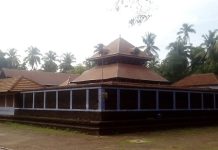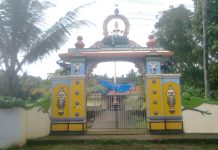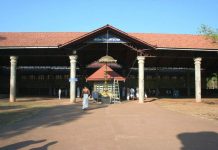
The Shri Mallikarjuna Temple, dedicated to Lord Mallikarjun, a divine incarnation of Lord Shiva, stands as a testament to Goa’s rich spiritual heritage. Located in the Sristhal village, 7 km northeast of Chaudi in Canacona taluk, South Goa district, this ancient shrine holds profound historical and cultural significance. Surrounded by majestic mountains, the temple’s tranquil valley setting offers a serene sanctuary for devotees and visitors alike. Believed to have been constructed in the 16th century, the Mallikarjuna Temple continues to inspire with its distinctive architectural features and serves as a spiritual beacon for seekers of divine grace.
Legend
The Mallikarjuna Temple in Sristhal village is steeped in captivating legends that add to its mystical aura. According to one legend, the temple’s location marks the sacred site where Lord Shiva and his beloved consort Parvati reunited after a prolonged period of separation. This divine union symbolizes the eternal bond between the masculine and feminine aspects of existence, exemplifying the inseparable nature of divine energies.
Another intriguing tale recounts a fierce battle between the demon Malla and the valiant Pandava prince, Arjuna. As the battle raged on, Lord Shiva assumed the form of a hunter and intervened, vanquishing Malla and saving Arjuna from certain defeat. In recognition of this divine intervention, the temple was named “Mallikarjun,” which translates to “the one who saved Arjuna.” This name serves as a reminder of the protective and benevolent nature of Lord Shiva.
The Linga housed within the temple is believed to be a Swayambhu lingam, meaning it is a self-manifested sacred stone. According to local folklore, the Linga was discovered by a member of the Kunbi community while clearing the forest. This uncut stone, in its phallic shape, represents the cosmic creative force and is adorned with a metallic mask, symbolizing the divine essence veiled behind a tangible form. The Linga’s presence further enhances the sanctity of the Mallikarjuna Temple and deepens its connection to Lord Shiva’s divine presence.
History
The Mallikarjuna Temple holds a fascinating historical lineage that traces its roots to the middle of the 16th century. According to a plaque near the temple dome, the temple was constructed by the ancestors of the Kshatriya samaj, hailing from the royal Surve family of Prachitgad near Shringarpur in the Ratnagiri district of Maharashtra.
The founding of the Kankunkar clan, to which these ancestors belonged, can be attributed to Prince Kashi Purush and his group of brothers. Seeking refuge from the wrath of Mahmud Gawan, who was displeased with their family’s shift in allegiance from the Bahmani Sultanate to the Vijayanagara Empire, they sought sanctuary in the region of Shristhal, Canacona. At the time, the Goud Saraswat Brahmins of Goa were known for their association with the Vijayanagara Empire, making Canacona an ideal settlement for the Kankunkar clan.
It is noteworthy that RaoRana Shurveer Suryarao (Suryaji) Surve, a prominent figure from the Surve family, remained in Shringarpur after the clash with Mahmud Gawan. Despite being Shivaji’s adversary, Suryaji earned respect and admiration from the great Maratha warrior, owing to his unwavering loyalty to the Bahmani Sultanate. This demonstrates the Surve family’s deep-rooted commitment and dedication to their ancestral heritage.
The Mallikarjuna Temple stands as a testament to the resilience and enduring spirit of the Kshatriya samaj and the Surve family, preserving their ancestral legacy and enriching the cultural tapestry of the region.
Architecture
The Mallikarjuna Temple is renowned for its remarkable architecture, showcasing intricate wood and silver carvings that captivate visitors. According to historical accounts, the temple was constructed by the skilled Habu Brahmins belonging to the Dravidian dynasty. The craftsmanship exhibited in the temple’s design is a testament to their artistry and expertise.
The assembly hall, known as the mantapa, features six pillars adorned with some of the finest surviving artwork. These pillars serve as a visual delight, depicting scenes from ancient scriptures such as the Puranas and the Mahabharata. One of the wooden pillars in the mandapa holds a special significance as the oracle pillar, where devotees seek divine guidance and blessings.
As one approaches the inner sanctum, intricately carved silhouettes of doorkeepers, known as dwarpals, greet the visitors on either side of the entrance. These exquisite carvings add to the grandeur and spiritual ambiance of the temple, showcasing the artistic prowess of the craftsmen.
Symbolism is deeply embedded in the temple’s design and sculptures. Across the 14 Mallikarjuna shrines scattered throughout Goa, a striking similarity can be observed in the phallic shape of the idols. These wooden idols, known as Nirakar or “formless” by the local population, are adorned with metallic masks and accompanied by Trishula, symbolizing Lord Shiva’s power and transcendence. These idols are believed to be remnants of the era when the Natha Sampradaya held prominence in the Western Deccan region. Additionally, the lingas housed within the shrines are believed to be Swayambhu lingas, self-manifested representations of Lord Shiva.
The Mallikarjuna Temple stands as a testament to the architectural brilliance and deep symbolism prevalent in ancient Indian temple architecture, offering visitors a glimpse into the rich cultural heritage of the region.
Festivals
The Mallikarjuna Temple is not only a place of worship but also a hub of vibrant and joyous festivities that bring together devotees from far and wide. Throughout the year, the temple resonates with the melodious sounds of devotional songs, the fragrance of incense, and the fervent prayers of the devotees.
One of the unique rituals celebrated at the temple is Shisharani, which alternates every year with the Veeramel celebration during the traditional Shigmo festival. Shisharani refers to a cooking ritual where rice is cooked in an earthenware pot placed on the heads of three men lying down with their heads touching each other. A fire is lit between their heads, and the rice is cooked while their heads are covered with wet cloth and layers of plantain trunk. This ritual holds significant cultural and symbolic importance.
The annual Jatra (procession) is another noteworthy festival celebrated at the Mallikarjuna Temple. On the day of the festival, in the early morning hours, the idol of Lord Mallikarjuna is taken out in a grand procession that lasts for approximately 2-3 hours. The procession culminates at the nearby Rajbag beach, where several rituals, including a special bath for the deity, take place. Devotees also have the opportunity to take a holy bath at the seashore. The sight of hundreds of devotees immersing themselves in the divine atmosphere creates a mesmerizing experience.
The Veeramel celebration is held once every two years during the traditional Shigmo festival. This midnight celebration involves selected local youth known as Gade, who rush from house to house carrying swords, accompanied by people playing drums and other musical instruments. The Veeramel celebration showcases the enthusiasm and energy of the local youth, adding a dynamic element to the festivities.
Another significant event is the procession of the Avatar Purush, which are smaller deities located in nearby places such as Asali, Khalvade, and Bhatpal. Once a year, these deities are magnificently carried in a procession at night to the main temple in Sristhal, where they are worshipped along with Lord Mallikarjuna.
In addition to these unique celebrations, the Mallikarjuna Temple also partakes in other common Goan festivals such as Rathasaptami and Shigmo, further enriching the cultural tapestry of the region. These festivals provide devotees with an opportunity to immerse themselves in spirituality, express their devotion, and connect with the rich cultural heritage of Goa.
Temple Timings:
The temple timings are from 7:00 am to 8:00 pm every day of the week.
Reaching the Mallikarjuna Temple
The Mallikarjuna Temple is situated in the Sristhal village, which is approximately 7 kilometers northeast of Chaudi in the Canacona taluk of South Goa district, India. While nestled amidst natural beauty in a valley surrounded by mountains, the temple is easily accessible by various modes of transportation.
By Air:
The nearest airport to the Mallikarjuna Temple is Dabolim Airport, located in Vasco da Gama, Goa. From the airport, one can hire a taxi or use public transportation to reach the temple, which is approximately 63 kilometers away.
By Rail:
The nearest railway station is Canacona Railway Station, which is located about 11 kilometers from the temple. Trains from major cities in India connect to this railway station, and from there, visitors can avail themselves of local transportation options to reach the temple.
By Road:
Visitors can reach the temple by road through private vehicles, taxis, or buses. Chaudi serves as a major transportation hub in the region, and from there, one can take a short drive towards the northeast to reach the temple. Well-connected road networks make it convenient for both local and out-of-town visitors to access the temple premises.
Once you arrive at the temple, you will be greeted by the serene surroundings and the spiritual ambiance that envelops the premises, providing an ideal setting for devotion and introspection.























































